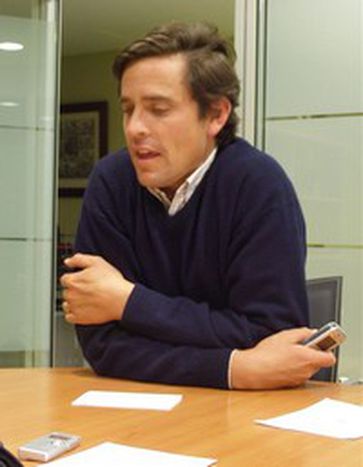
Eduardo Dávila Miura: 'a bullfighter never thinks about his own death'
Published on
Translation by:
 sarah meleleu
sarah meleleu
He was one of the best Spanish bullfighters, until he ended his career in autumn 2006. The 33-year-old talks about the loneliness of the arena and bullfighting as an art form
An actor and a torero (bullfighter) meet. The actor says to the torero, 'actually our jobs are really similar. We both appear before audiences and we could both lose our lives.' The torero answers 'that’s true. Only you can die several times – but not I.' Eduardo Dávila Miura roars with laughter as he tells us this joke, his mouth stretching wide open and his eyes twinkling mischievously.
Deep connection
When he ended his ten-year long career in October 2006, Dávila Miura was one of the most famous Spanish bullfighters. He won many awards during this time and has appeared not only in his native Andalusia but all over Spain, Portugal, the south of France and Latin America. The 33-year-old’s resignation came as a surprise to many people. 'I achieved everything and reached the highest point. So I thought, now is the best time to stop,' he reflects, as he explains his decision.
Dávila Miura has been surrounded by bullfighting since he was born. The Andalusian comes from a famous bull-breeding family from Seville, the city where he was born and also in which his career began and ended. He explains how he had already trained with bulls on his parents’ farm as a youngster and so was always familiar with their behaviour patterns and peculiarities. For him, a relationship with the animals is essential to being a good bullfighter. 'As a torero you have a deep connection with the bulls,' he emphasises. 'That’s exactly what most people don’t want to understand.'
The intensive dual with the bull inevitably reveals the soul of the torero. 'The way you fight reveals who you are,' Dávila Miura quotes the famous Andalusian bullfighter Juan Belmonte. 'As a bullfighter you’re completely alone, even if thousands of people are watching your fight. It is an unimaginable loneliness. The only thing you can sense at that moment is the bull.' The aim is to read the animal’s character; there are different types of bulls and you have to fight in a different way with each one. 'There are also dishonest bulls, real actors,' he laughs. If you heard Dávila Miura talk about bulls, you would be able to sense the love for the animals he grew up with, and of which he has killed so many in the arena.
Art and cruelty
He likes to compare bullfighting with a work of art, the torero with an artist. 'Bullfighting is a drama which follows a detailed choreography,' he continues. This drama has three acts, the 'Tercios'. First, the bull is provoked and wounded, but everything rests on the last act: 'at the end the torero gives the deadly thrust with a sword.' With these words Dávila Miura demonstrates the movement with his enormous hand, and with it captivates our gaze.
'Utmost concentration is needed to know when the right moment has come. You are an artist, but unlike a painter or a writer, you only have one chance.' The sole aim of a bullfighter is the death of the bull: for that every torero puts his life in danger. Had he never thought of his own death? Dávila Miura shakes his head and his lips twitch with contempt: 'a torero never thinks about his own death.'
However a bullfight is not simply an elaborate and artistic display - it is also cruel. The final stab of the matador is carefully prepared by the assistants, the picadores (the horseman who pricks the bull with a lance early on, to keep its head low) and banderilleros (implements used by the bullfighters’ assistants to stick the bulls). They wind the bull gradually with lances and spears until it roars with pain.
Corridas (bullfights) are becoming less and less popular in Spain, especially amongst young people. 'Perhaps bullfighting is in trouble at the moment. But we toreros don’t care about that.' Dávila Miura seems to wipe all doubts aside with a hand movement. For this 'handful' of critics, he only has a contemptuous look. How would he persuade a sceptic to set foot in a bullfighting arena? 'He would simply have to see a corrida. And he would have to understand the most important thing about bullfighting: the bull was born to die.'
Dávila Miura reluctantly talks about the dark side of his job. When he goes into raptures about torear (bullfighting), the passion penetrates every fibre of his powerful body. He finds it extraordinarily difficult now, after his resignation, to become a mere spectator again. 'It’s hard to just watch other fights. Bullfighting is my vocation.' But after all he does have a family and children, and that makes it difficult to carry on such a dangerous job. He has been injured eight or nine times. What would he say if his son came to him one day and said that he wanted to be a torero? Dávila Miura stops short, but then carries on determinedly: 'I would be very afraid for him, because it is a hard and dangerous life. But I would allow him to do it. After all, it's the best job in the world.'
With thanks to Eduardo S. Garcés
Translated from Eduardo Dávila Miura: Ein Torero denkt nie über seinen Tod nach


